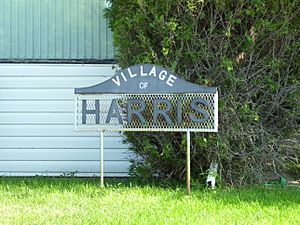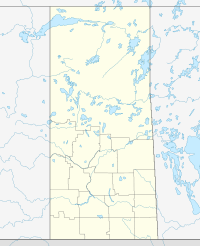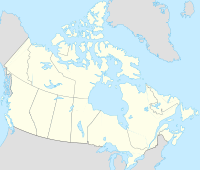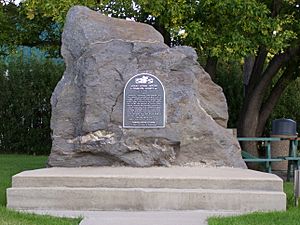Harris, Saskatchewan facts for kids
Quick facts for kids
Harris
|
|
|---|---|
|
Village
|
|
| Village of Harris | |
 |
|
| Country | Canada |
| Province | Saskatchewan |
| Region | Central |
| Census division | 12 |
| Rural Municipality | Harris |
| Post office founded | 1906 (at an outlying location) 1909 (at the village's current site) |
| Incorporated (village) | August 10, 1909 |
| Government | |
| • Type | Municipal |
| Area | |
| • Total | 0.72 km2 (0.28 sq mi) |
| Population
(2016)
|
|
| • Total | 193 |
| • Density | 259.5/km2 (672/sq mi) |
| Time zone | UTC-6 (CST) |
| Postal code |
S0L 1K0
|
| Area code(s) | 306 |
| Highways | |
| Railways | Canadian National Railway |
| Website | Village of Harris |
Harris is a small village in the Canadian province of Saskatchewan. In 2016, about 193 people lived there. It's part of the Rural Municipality of Harris No. 316 and Census Division No. 12. The village is famous for a strange event called the Great Ruby Hoax, which happened in 1914. Harris got its name from Richard Elford Harris, one of the first people to settle in the area.
Contents
How Many People Live in Harris?
In the 2021 Census, Harris had a population of 190 people. These people lived in 95 homes. This was a small change from its 2016 population of 193 people. The village covers an area of about 0.89 square kilometers.
In the 2016 Census, Harris had 193 people living in 96 homes. This was a slight drop from its 2011 population of 213.
A Look at Harris's Past
Before European settlers arrived, Indigenous people, likely the Plains Cree, lived in the Harris area. You can still find signs of their presence. For example, in the Bear Hills north of Harris, there's a turtle effigy (a shape made on the ground), vision quest sites, stone rings, and rock piles.
How Harris Began
The modern story of Harris started in the early 1900s. The village is named after Richard Elford Harris. He was a carpenter from Ontario who moved west in 1904 with his two sons and a daughter. The Harris family traveled from Saskatoon on an old trail. They settled on land that later became known as Crystal Beach.
Their sod house became famous as the "Harris Stopping Place." It was a rest stop for settlers moving into the area. Travelers could rest themselves and their animals. They could also get a hot meal. The Harris men would then guide them to their new homesteads. Because so many people came, a store, a Methodist church, and a post office were built. Mr. Harris became the first postmaster.
Moving the Village
Soon, the Canadian Northern Railway planned to build a rail line, called the Goose Lake Rail Line, connecting Calgary with Saskatoon. But the railway was going to be built two miles away from the original community. So, the people of Harris quickly bought land along the new rail line. They moved the entire community to its current spot, which was at mile 52 of the Goose Lake Line.
The move meant the community needed a new name. Many names were thought of. But when Richard Harris was allowed to move his post office to the new site, the name Harris went with it. That's how Harris, Saskatchewan, was born! The first train came through the community in the fall of 1908. Harris officially became a village on August 10, 1909.
Harris Through the Years
As the 20th century continued, Harris saw many changes. Many businesses opened and closed over the years. Some old buildings from the early 1900s are still standing today.
In 1916, the first telephone company was set up in town. In the 1920s, cement sidewalks were built. In 1930, electricity came to Harris. In 1955, natural gas was added, and a sewer system followed in 1960. The 1970s saw a big project to pave the streets, which finished by 1980. In 1976, the village got its own water treatment plant. Today, Harris has almost 200 residents and many successful businesses.
Old Buildings in Harris
Several buildings in Harris are protected as Municipal Heritage Properties. This means they are important historical sites. They include:
- St. Brigitte Roman Catholic Church: This is a one-story wooden church with a tall steeple. It was finished in 1909.
- Rural Municipality of Harris #316 Office: This is the oldest office building still standing in the Village of Harris.
- Harris United Church: This is a one-story wooden church with a bell tower on the corner. It was completed in 1924.
- Royal Bank of Canada: This is a one-story bank building made of red brick. It was built in 1922.
- Old Harris Canadian National Railway Water Tower: This is an eight-sided wooden water tower. It was built in 1934.
The Great Ruby Rush Hoax
This is an amazing story about one of the strangest events in Saskatchewan's history: The Great Ruby Rush.
The Discovery

One hot, dry day in the summer of 1914, an American miner named Alex McCarthy was working on a road crew. He was in the Bear Hills, about 20 miles northwest of Harris. He noticed some red rocks in a large black stone. He thought they might be rubies. Seeing a chance to get rich, he hid the stones in a cigar box. Then he went to the Commercial Hotel in Harris.
Over a glass of beer, McCarthy showed the "rubies" to the Gordon Brothers. They owned the hotel and were known to have some mining experience.
The Rush Begins
The Gordons quickly went to Saskatoon to claim the land. While they were there, news somehow got out about the ruby discovery. Headlines in the Saskatoon Star newspaper announced a ruby and gold discovery near Harris. Word spread very fast! Within days, thousands of prospectors (people looking for valuable minerals) arrived in Harris hoping to find their fortune. The Ruby Rush had begun!
The Gordon brothers made the most of the Ruby Rush. "Rubies" from the discovery site – a large black stone from the Bear Hills – were put on display at their hotel. The clever Gordons sold the miners everything they could possibly need.
The Truth Comes Out
Less than two weeks later, news came from Saskatoon. The "rubies" were not real rubies at all! They were worthless garnets. Just as quickly as it had started, the Ruby Rush was over.
For years, rumors said that the whole thing was a hoax. People believed the Gordon Brothers created it to make money. For a long time, the Ruby Rush was a topic people avoided talking about in town. This was partly because the main people involved and their families still lived there.
Today, the town is not shy about its connection to the Great Ruby Rush. In fact, they are proud of the story! The original "ruby" rock is now displayed in town, outside the museum. For many years, every July, the town celebrated annual Ruby Rush Days. The hotel in town is even named The Harris Hotel Ruby Rock Pub & Grill.
A plaque on the large rock next to the Harris Museum explains part of the story:
Headline. Saskatoon Star Phoenix: July 1914 "Quartz Discovered 20 Miles N.W. of Harris" Suddenly the ruby rush was on! Lasting 10–12 days, at its height 3000 people were involved at the site, staking out claims and digging up stones. Tents housed saloons, restaurants (one egg at 1 dollar), and this rock, guarded by armed guards, containing the so-called rubies. The ruby rush was soon discovered to be a hoax as the rubies were garnets of little value. This ruby rock was moved from its original site in 1990.
—Harris' Great Ruby Rush Hoax - Saskatchewan Historical Markers
Famous People from Harris
Harris is the birthplace of Quintin Laing. He is a left-winger who played in the National Hockey League.
Places to See in Harris
The community has many interesting places to visit, including:
- The Harris Museum and its related items:
- Other places:
Climate in Harris
Harris experiences a typical prairie climate. This means it has cold winters and warm summers. The weather can change quite a bit between seasons.


















